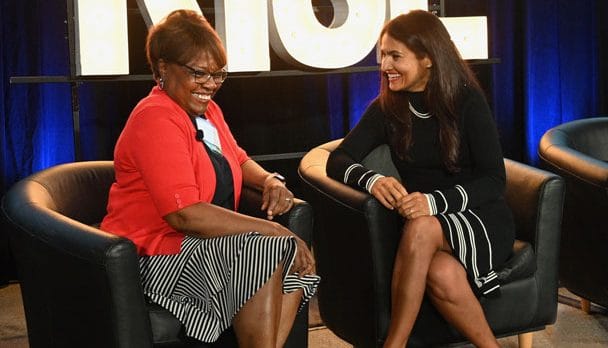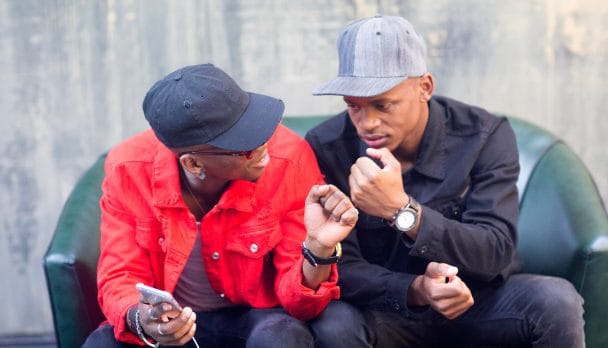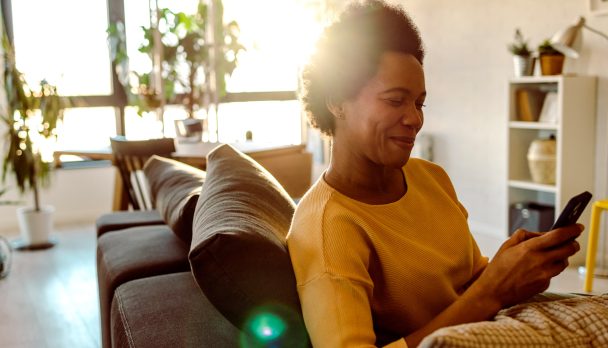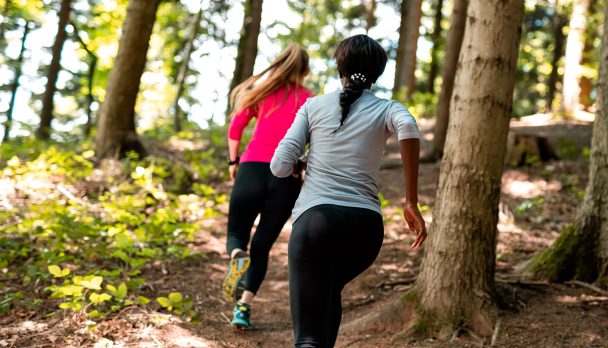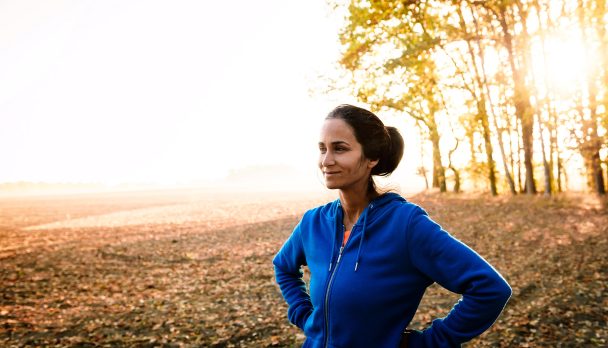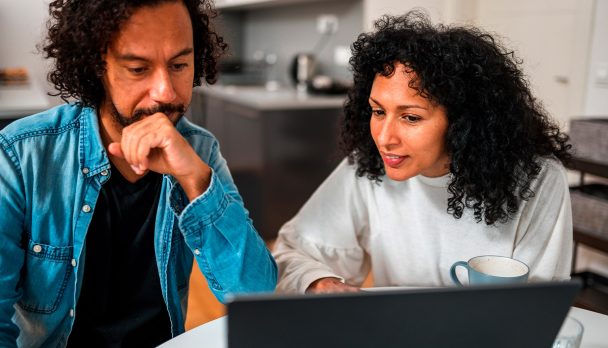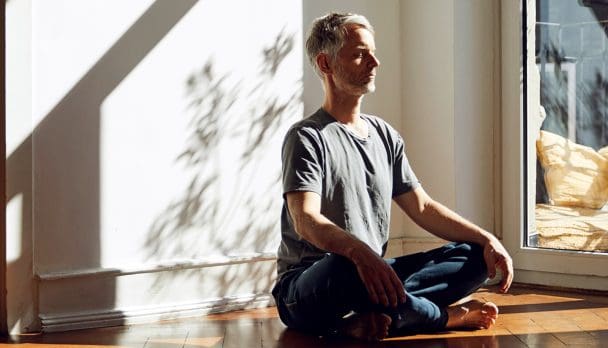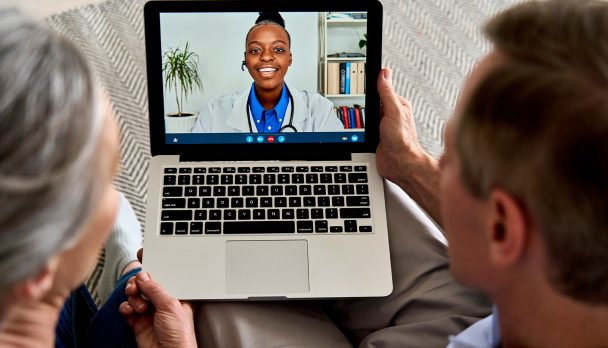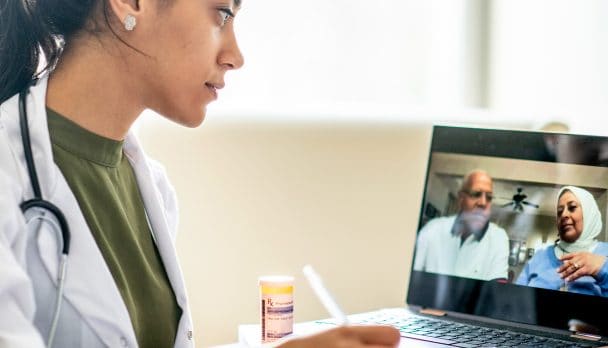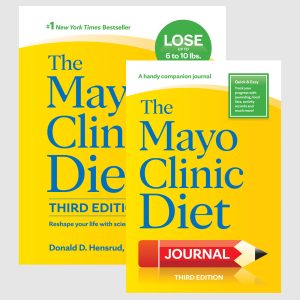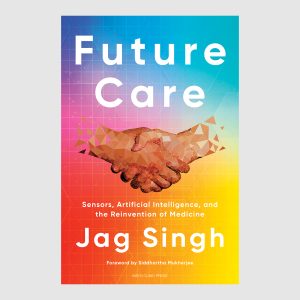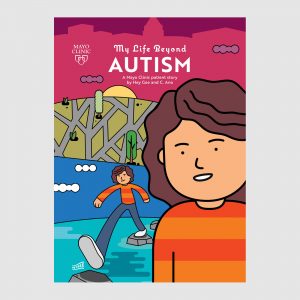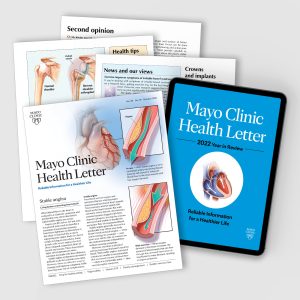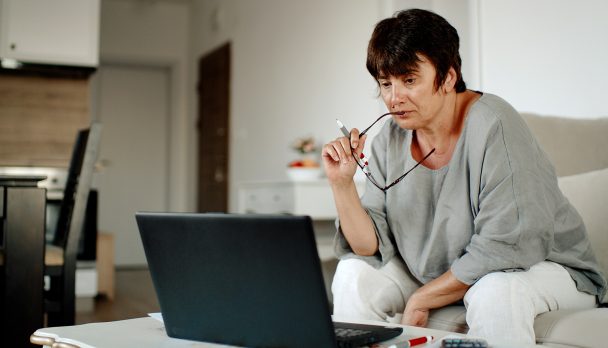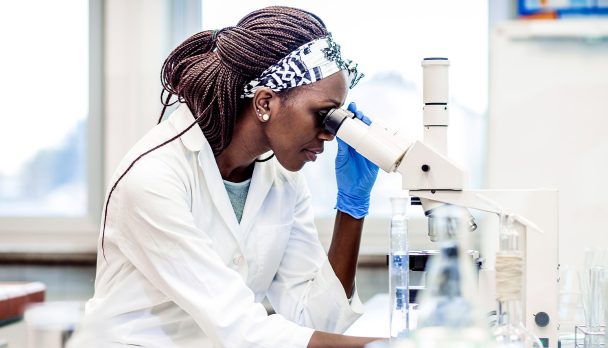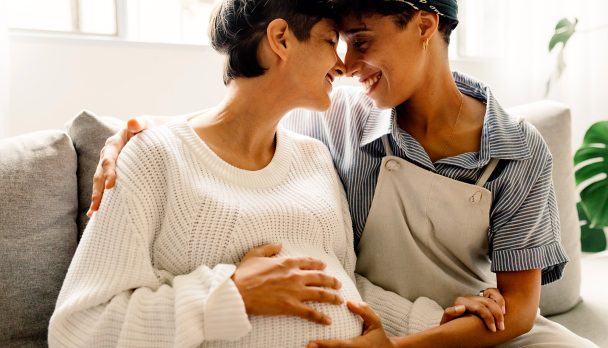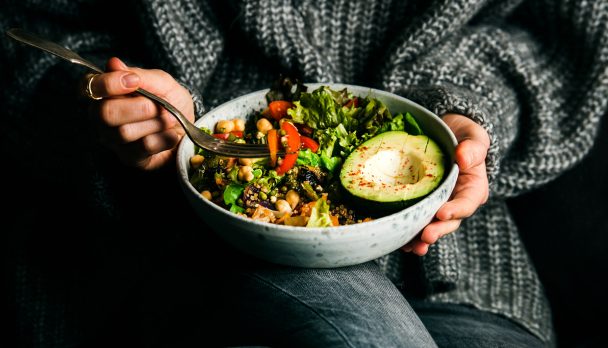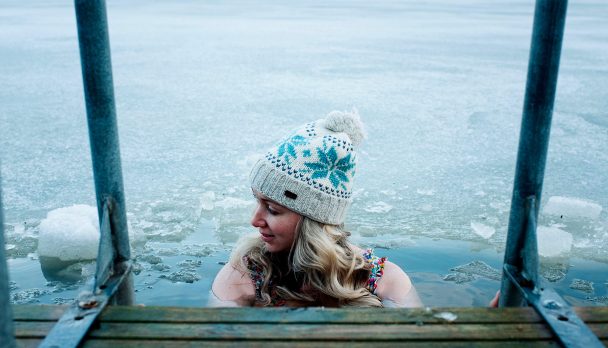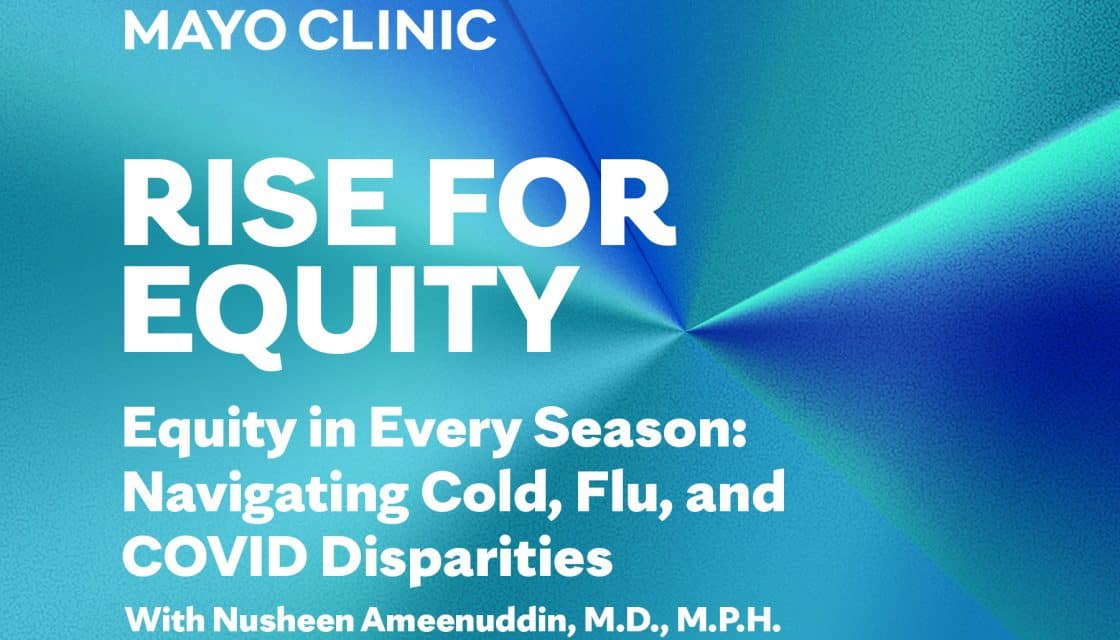
Flu and cold season is an annual concern for people around the world. Specifically in the United States, there are massive disparities in both care and outcomes for communities of color related to both diagnosis and treatment of flu and cold. On this episode of the RISE for Equity podcast, Dr. Nusheen Ameenuddin joins host Nicole Nfonoyim-Hara to discuss COVID’s impact on cold and flu, protecting our communities, and how we can improve education and access to care for marginalized communities.
“The truth of the matter is genetically, we’re all very similar. It’s not an issue of race, it’s an issue of racism. When we actually step back, people can be like, ‘Oh, that situation was a one-off.’ And when we actually look at the data, it’s not a one-off. The fact is, we’re not asking the right questions, and we need to look deeper to ensure that we are providing the best possible care, the most objective care, the most patient-centered care, particularly when we see that we’re falling short. And, and the numbers don’t lie.”
Guest: Dr. Nusheen Ameenuddin is currently an Assistant Professor and Consultant (tenured staff physician) in the Division of Community Pediatric and Adolescent Medicine, Department of Pediatrics, at Mayo Clinic, Rochester, MN.
Read the transcript:
Nicole Nfonoyim-Hara: Hello and welcome to the Rise for Equity podcast. I’m your host, Nicole Nfonoyim-Hara. On today’s episode, we’ll be talking with Dr. Nusheen Ameenuddin, a pediatrician at Mayo Clinic in Rochester, Minnesota, about the impact of cold and flu season on marginalized communities and how COVID 19 has changed how we care for ourselves and our communities.
Welcome, Dr. Ameenuddin. I want to start by asking about your personal story. Why did you go into medicine and how have you centered advocacy in your work?
Dr. Nusheen Ameenuddin: Well, first of all, thank you so much, Nicole. It’s lovely to be working with you again. Thrilled to see you. I am a pediatrician with a large community population.
The reason that I went into medicine was because it was actually a fairly personal story. I loved the idea of being able to connect with people and my own background as someone who grew up in an immigrant family, even though my father and mother were educated and came over from India.
Basically, when you come as an immigrant, oftentimes you have to start from scratch and after my father had finished his Ph.D. program and was out, in the job world, it became clear at that time that insurance was not something that was affordable for the rest of the family, and so I was just very lucky. I did not have health insurance for a very long time, really, actually, from the time my father graduated until the time I started medical school.
I was just really lucky that I didn’t get sick. But I remember, even when things would happen it was something that we would have to pay out of pocket. It always struck me as an injustice, even though I didn’t have the words for it when I was young, that people couldn’t just access care and that it would be so terribly expensive.
As a pediatrician now, obviously, in the last 20 plus years, we’ve had the child health insurance program.
We’ve had Medicaid expansion that has covered so many more kids and even adults. One of the things I’m really grateful for in the state of Minnesota is we’ve had some record high levels of coverage for kids.
Even though coverage doesn’t automatically equal access, if you don’t have coverage, you’re not going to be able to access the care that you need, whether it’s basic medical care, preventive medical care, or care for colds, flus and the more serious sequelae that can sometimes come with that.
Nicole Nfonoyim-Hara: Thanks for sharing that. So before we dive into community education and impact, I’d love to start with some definitions. Can you explain how cold and flu are categorized as illnesses and how they’re different from COVID?
Dr. Nusheen Ameenuddin:Having a cold or an upper respiratory infection is kind of a broad way to categorize a number of different viruses that commonly circulate at different times throughout the year.
Some are more prominent during certain times of the year. Before COVID we used to think of this as cold and flu season because we would see an increase in upper respiratory infections caused by viruses and influenza or flu, which is also caused by a virus, but is a little bit different from other things. COVID of course is also a virus, but we have learned that viruses can evolve, viruses can mutate, and that can really have an impact on how severe they are, or how potentially deadly they are.
Coronaviruses were circulating well before we heard about the COVID 19 pandemic, but just were not mutated or evolved to the point that they were causing as severe conditions as they have over the last few years. So viruses are all around us. Bacteria are also around us. Bacteria can oftentimes be treated with antibiotics, but viruses cannot. It’s interesting. I think about this as a pediatrician on a regular basis, and I was reading recently that about 40 percent of parents, when they bring their child to the pediatrician’s office, are expecting antibiotics.
They’re expecting something that will make their sick child well. Nicole, you’re a parent.
You know exactly how frustrating, how heartbreaking, how difficult it can be to take care of a sick child. Sometimes the hardest thing that my colleagues and I have to do is say it’s, quote unquote, just a virus and it’s going to have to run its course. There’s unfortunately no medicine.
There’s no antibiotic that is going to be able to treat a virus. The majority of the illnesses we see are caused by viruses, so on the one hand it’s maybe reassuring that they don’t need medicine, but it also means they’re going to be sick and there’s nothing we can do, unfortunately beyond saying, watch for this, watch for this. If this happens, come see us again.
Nicole Nfonoyim-Hara: Yeah, I know it’s super frustrating when kids are sick and there isn’t medicine to fix them. I think the best case is it runs its course and they get better. Kids are very resilient for the most part in terms of being able to rebound from illnesses. But it’s still so hard to see them sick and not be able to fix it
I want to talk a little bit more about COVID 19. Can you tell us how COVID has impacted our immunity to colds and flu? We know these viruses are floating out there and causing multiple overlapping infections. So how do these illnesses interact and how are kids specifically impacted by that?
Dr. Nusheen Ameenuddin: I would say if there’s a good thing that’s come out of this whole pandemic, it’s that we are studying the effects of the impact of viruses more than we used to, because again, we used to sort of pass it off as, it’s just a cold.
There are plenty of coronaviruses that circulated that were just a cold. But as we learn more and more about COVID 19 specifically and its variations, we are learning that it actually has a pretty significantnegative impact on immunity. Very early on in the pandemic, as we were all learning things, we were just trying to stay on top of things, it seemed that COVID was not affecting kids too badly.
But we are learning now, long term, probably 15 or more percent of kids, even if they have a very mild case, or sometimes an asymptomatic case that that actually is affecting other aspects of their health care. We have found that there has been a hit to the immune system in a couple different ways. In some cases, we found that it’s erasing memory of immunity to other viruses and other things, which is fairly serious. We’re finding longer term fatigue.
We’re finding crazy neurological findings in kids that don’t really have an answer. We’ve had big increases in POTS, which stands for Postural Orthostatic Tachycardia Syndrome.
The long and short of that is it’s a medical condition where kids and teenagers may otherwise seem healthy, but they get very fatigued, even standing up. They can get dizzy. It’s really a debilitating condition, and we’re fortunate that at Mayo Clinic we have a special POTS clinic because we’ve seen a big increase in POTS diagnoses in kids. We’re also learning that the kids, oftentimes the ones who have the underlying asthma, which is disproportionately affecting populations from the Black community, Latino, Native American, American Indian communities in a really difficult way, we’re also finding that, a year, two years ago, as we were looking at how COVID had impacted families in ways that are not strictly related to immunologic, or hospitalizations, or mortality, is that kids who were from communities that were not white, were much more likely to have lost a caregiver.
So that is a parent, a grandparent who died of COVID, and being an orphan, or partially orphaned is not a small thing for a kid. We’ve seen rising rates of depression anxiety, eating disorders, but losing a parent or a caregiver is a huge, huge thing. That’s something I think that we haven’t paid enough attention to.
We do know that widely, disproportionately, as much as COVID has affected every group, it’s groups that have traditionally been under resourced or currently under resourced who may not have access to the vaccines as easily or other care who have really had the burden.
And just in the last week or so, I looked at some data about masking and it pointed out that people from the Black and Latino community were more likely to keep masking. I think it’s because the impact has been so profound in the communities, unfortunately.
Nicole Nfonoyim-Hara: I’m so glad you brought that up. I remember there were stories that really struck me during the darkest parts of the COVID pandemic, like the fact that Native, Black and Latino communities were losing whole elder generations.
These are people who are culture-bearers and teachers and people who carry the traditions. A lot of the time, those are people who are also primary caregivers for youth and young adults in those communities.
Now they’re completely decimated. Those losses have lifelong and community-wide impacts. Then you look at things like the mental health impact of that kind of pain and the lack of access to good care.
It all comes together and it makes it so hard for communities to move forward. It seems like those social and cultural impacts will continue. So I’m thinking a lot right now about how we get information to our communities because if access is an issue that probably includes lacking access to accurate and easy to understand health education.
As a pediatrician, I’m sure you’re caring for your fair share of patients with cold and flu symptoms, in addition to COVID. With your pediatrician hat on, how do we get information about prevention and treatment of viruses like this to marginalized communities who may not have as much access to education or medical care?
Dr. Nusheen Ameenuddin: As someone also who has a public health background, education on a large scale level is so important to me.
So how do we get that information to communities? I think we have seen successes and failures especially over the last few years with messaging to communities about COVID, and what we’ve learned over many years, and as a pediatrician this is nothing new for me, we’ve been dealing with vaccine hesitance even flat out anti vaccine campaigns.
We know that people like to get information from trusted sources and oftentimes trusted sources for parents, for families, are people who they know, are people in their own communities. As much as we’d love to say we want paper patients to come into the clinic and we hope we’re doing a good job of educating them, not every family can make it in sometimes past the threshold of the clinic door.
What do we need to do on a large scale in communities? And I think a lot of what we’ve learned is, is letting families know, well, here’s what to watch for if things get bad, but also let’s talk aboutprevention.
In public health I remember learning this 20 something years ago, when I first did my degree, that when public health works, nothing happens, and it’s hard to get people excited about nothing.
It’s only unfortunately when really terrible things happen that we realize how important the public health infrastructure is. Going back to your question about how we educate what we have learned, pediatricians in particular have said, okay, do we need to get onto social media?
Do we need to reach parents where they are? We’ve tried to say how can we harness these great communication tools we have to serve as people who are providing accurate information, vetted information that can then, we hope, go viral among communities to encourage them to get vaccines.
Nicole Nfonoyim-Hara: I was thinking about that education piece so much because it’s so layered, and it has to go through so many different platforms like social media, printed ads shared in a variety of languages. There’s a huge need to get that information out in as many ways as we can. So obviously during the COVID 19 pandemic, one of the pieces of information we heard a lot about was the 1918 flu pandemic.
Because the flu is such a common part of our lives now, we often forget that 500 million people died in the 1918 pandemic globally. It’s almost a third of the human population, and a lot of historians acknowledge that vaccinations were a huge reason we got out of that pandemic. So can you tell us a little bit about how vaccinations have changed since the last major global pandemic, and how we can look at equity and access to vaccination at this point?
Dr. Nusheen Ameenuddin: As a pediatrician, vaccination is an issue that’s very close to my heart. It’s something that we literally have decades of evidence for. We saw a curtailing of deaths in children when the smallpox vaccine was introduced, when the flu was introduced.
It’s interesting because like even today, with this very sophisticated medical care living in Rochester, not just a tertiary, but probably a quaternary healthcare facility, we think, oh, you know, it’s probably not that bad. I have lots of people tell me, oh, it’s just the flu.
But what we don’t realize is that the flu still kills so many people and it’s a big killer of children. Unfortunately across the world we are very fortunate to have vaccination as one of our tools to decrease both mortality deaths from flu, but also decrease the severity of flu in other people who might otherwise be more vulnerable.
When we talk about this from an equity standpoint and vaccine access, unfortunately the flu vaccine for many people is not free. Ideally, if you have some type of insurance, whether it’s Medicaid, medical assistance or private insurance, you should be able to access it, but that can be a challenge.
There are oftentimes free flu clinics, but you have to have transportation, you have to know where they are, you have to make sure they don’t run out of resources. I remember maybe getting my first flu shot when I was in high school. That was when they were first starting to introduce them.
Then I remember in subsequent years they would just run out because so many people wanted them.I’ve seen the whole vaccination issue shift. We have people who are on the anti-vax side. I have families who ‘ll do every vaccine except the flu vaccine. There’s a common myth out there that the flu vaccine gives you the flu and that’s not the case.
It is normal, and even though it’s unpleasant sometimes your body will appropriately mount an immune response, which can mean that you have a fever, which is no fun. It can mean that you feel a little yucky, a little bit achy, but that’s not the same as getting the flu.
That’s not the same as actually being sick with something. So again, from an equity perspective, we know that in the United States, only about one in two people gets their flu shot. We have to ask why. Are there barriers, or is it personal beliefs? Is it the spread of misinformation and disinformation?
Are there myths that we can that we can help correct with information, or is it a deeper issue related to trust? When we look specifically at Black, Latino and Native American populations, only about 43% of those populations are getting the flu shot, and we do know. We have very strong evidence in pediatrics that it’s those kids with asthma and kids with other underlying conditions, but even kids who otherwise seem perfectly healthy.
We can seriously reduce the risk of hospitalization and death, which again, is something we deal with as pediatricians and it’s sometimes really connecting with people one on one.
Nicole Nfonoyim-Hara: It’s your responsibility to continue to be persistent and continue to champion the case for prevention and care. As I was listening to you, I was putting my anthropologist hat on because so much of this has a cultural weight to it in terms of how people are getting their information, what information they’re getting and who they trust in terms of their community’s history with healthcare institutions and providers.
I think that’s particularly relevant for the communities that we’ve just spoken about, including Black communities, Native and Latino communities in this country. On top of that we can think about global communities and how immigrant communities have been treated when it comes to vaccinations and global health research.
So as providers and educators, you’re having to navigate all of that history in order for people to get the best care.
When I’m thinking about access, I think about my own experiences with it. Of course. My daughter’s in kindergarten and for the first time ever, they had a flu shot clinic at her school, and even though I’ve personally got the privilege and the access to get her a flu shot outside of school, it was so easy to access that kind of life saving care.
She showed up at school that day and she just got her flu shot. I don’t have to think about things like taking time off of work, transportation, taking her out of school or anything like that. It’s so important to have that kind of community and public health care available. Even at my church the other day, there was a flu shot clinic for the elderly people in the community to get their shots.
I think when we talk about access to vaccination as a whole, we can look at what we learned from the COVID pandemic and see the roots of bad health outcomes that run so deep, especially in marginalized communities.
Before we started recording, we were looking at a report released by the CDC in 2023 about flu vaccination rates for different racial and ethnic groups. That report highlighted some serious gaps in terms of health equity related to both vaccination rates and overall health outcomes for marginalized communities. Can you share a little bit about how those gaps show up in your clinical setting?
Dr. Nusheen Ameenuddin: Unfortunately it’s not new. It’s not news that there are these inequities and we see them at pretty much every level that are disproportionately impacting Black, Latino and Native American communities.
I think when we think about just cold viruses and as much as we call them just a cold viruses can actually be pretty nasty and it doesn’t have to be COVID, it doesn’t have to be influenza but, even a quote unquote simple cold that causes an asthma exacerbation in a child who has asthma that makes them have to go to the emergency department for urgent treatment, or get them hospitalized is something that we see a lot more in Black, Latino and Native American communities.
Looking at the disparities of influenza, it’s not surprising at all for those of us who’ve kind of been watching the trends. It’s disheartening. It’s always disheartening.
We look at that and we think, okay, is there some sort of an intersection between being able to access appropriate preventive care. If you don’t have insurance, you probably can’t afford the inhaler, the steroid inhaler that your child is on and unfortunately, we’ve had just in recent months, people lose Medicaid status just because of filing errors, because of clerical errors.
During the COVID pandemic there had been extensions of Medicaid where you don’t necessarily have to go in every single year to recheck, but people have fallen off that. If you find yourself with a gap in coverage, that can severely impact your ability to keep your child well.
That’s one of the reasons where, even before this was all pandemic related, if you have gaps in coverage, if you move, if there’s paperwork that maybe English is not your first language, maybe health literacy or other literacy issues can impact your ability to fill out forums that are not easy to fill out, that that can actually have a huge impact down the line for health and wellbeing.
Again, being close to a place where you can access care for your child, that’s an issue for people who live in rural areas. Also an issue for people who live in urban areas, even if you’re surrounded by something, do you have the transportation to be able to get there?
There is understandably some hesitation sometimes in terms of trust. But again, if you can’t access the care to begin with, how do you even get to the point where you can access that? So, that plusenvironmental factors that increase the risk of asthma, which again, underlying condition, which can make a simple cold not so simple for a child, or someone else can significantly impact the way your body responds.
Nicole Nfonoyim-Hara: Thanks for giving some great examples of the different barriers to access. I think sometimes when we’re discussing health equity, we hear that certain populations are, quote unquote, vulnerable, or at risk for certain illnesses or severe outcomes. Then we hear the language and we think, okay, am I more at risk because I’m a Black woman, for example, but is it that I’m more at risk just by virtue of my race? Or is the real question, what is making certain groups vulnerable and at risk? What are the root systemic causes of those gaps?
I want to stay with that a little and talk about the upstream causes of the gaps that we’re seeing. I’m particularly curious about care for communities of color, but we also know that there are other intersections there like class, gender, etc.
Dr. Nusheen Ameenuddin: In the last few years, we’ve really been reckoning with this in medicine, looking at the questions we haven’t asked, looking at the wider view. You mentioned there are these intersections of race, ethnicity, class, socioeconomic status, education and are you at greater risk as a black woman than someone else?
The truth of the matter is genetically, we’re all very similar. So when you’re talking about that, I was thinking about how it’s not an issue of race, it’s an issue of racism. And I’m going to pause for a second because I know people hear that word, and even though this is a podcast podcast on equity, and hopefully we’re comfortable using accurate words like that to describe, it can still make people really uncomfortable, especially in the medical field, because we’re taught, no, no, no, we’re not seeing race for ever so long and still we try to think that we are objective and that we’re very science based.
We’re looking solely at the evidence and the truth of the matter is we’re not as objective as we think, and that’s a really hard thing to admit. That’s a really, really difficult thing to admit. Particularly when you’re a person in what’s considered a caring profession, in a profession where like, nope, I just look at data.
You asked the question about, are you at greater risk, and the sad truth is the way society is now, even though you have access to medical care, you’re an employee of the Mayo Clinic, you’re at higher risk. We are challenging ourselves to really dive deeper.
Is it that we as physicians, clinicians are not listening as well? Our implicit and explicit biases coming out in ways that we don’t necessarily want them to but are they coming out? And so it really is a racism issue rather than a race issue, because genetically it’s really not. It shouldn’t be a problem.
I keep going back to the Serena Williams example, one of the top athletes. I mean, if there’s anyone who’s in tip-top shape, if there’s anyone who has the resources, who has the command of an audience, the influence. She had an almost fatal outcome when she was giving birth to her child.
When we actually step back people can be like: “Oh, that’s a one off.” When we actually looked at the data, it’s not, it’s not a one off. The rates for maternal mortality are much higher for Black women that transcend education, socioeconomic status, access to insurance, and it shouldn’t be that goes against everything we kind of learn in public health.
The fact is we’re not asking the right questions, and we need to look deeper to ensure that we areproviding the best possible care, the most objective care, the most patient-centered care, particularly when we see that we’re falling short. And the numbers don’t lie.
I think there are a lot of people who are still scratching their heads. It’s very difficult. It’s hard for us to acknowledge that. I do want to give a shout out to. One of my colleagues, Dr. Tiffany Johnson, Pediatric Emergency Medicine Physician, who has really delved into the issue of our Black children treated in, in a differential way.
Being an emergency department physician, she’s published along with her colleagues, some important things that are really hard to stomach. She found that when Black children, Black and African-American children came into the emergency department, they were not given as much pain medication as non-Black children.
That’s hard as pediatricians we come into the room, we coo over all the kids. We think everyone’s so cute and the fact that we’re not addressing the pain needs of kids through implicit explicit bias for other reasons is really a difficult thing.
It’s a difficult thing. But we have to acknowledge that that’s the truth and that we need to address it. She also did a study, which was very interesting. As we were kind of talking about disparities and cold and flu treatment and all those things, as I mentioned earlier, we don’t treat viruses with antibiotics.
Antibiotics are not going to have an effect on viruses even if parents come in with the expectation that my kid is sick. I want antibiotics. What she learned is that kids, again, from Black families, were not given antibiotics for viral infections. On the one hand you’re like, but that’s the right thing to do. That’s what should be happening. That’s not appropriate. There can be side effects to these antibiotics that are not going to help kids anyway.
But you also have to step back and say, so what’s happening here? Are our parents not being listened to? Do they not feel empowered to advocate for their children in a system where traditionally therehave been some very serious things that we’re still reckoning with.
So, why is that happening? Why does that disparity exist? It’s not that racism is protective, and I say that because some people have drawn that conclusion and we’re like, no, no, no, no, we need to look a little bit deeper and definitely much more widely before making that kind of incorrect conclusion, but what it tells me, Dr. Johnson’s work, especially in these two areas, is that Black families are not getting the same level of care as other families and that is a problem. That is a problem that we really need to address.
Nicole Nfonoyim-Hara: Thank you for sharing all of that. I know it’s really hard having to face the very difficult realities of that knowledge as a provider and a patient. I mean, I remember hearing the story about Serena Williams almost dying in childbirth and a lot of the other data around Black families visiting the emergency room.
It’s so hard from that angle because, of course, it exacerbates trust in the medical system. But also, as I was listening to you, I was also thinking about how hearing those stories can also spark us to take action ourselves as patients. I was having my second child around the same time that Serena Williams shared the birth story of her first child.
And I remember going to my provider and saying, I have concerns about this. And it gave us an opening to have a serious conversation about my risk and outcomes. When we learn about the systemic racism in medicine, we can also work on changing that. I’m sure you know, as a provider, how important that patient provider relationship is.
And that relationship extends through the family and into the community in a lot of ways. What resources can patients use to advocate for themselves or their loved ones? What questions should they be bringing to their providers?
How can providers and patients work together to be educated on community specific issues and how they can achieve the best outcomes for care?
Dr. Nusheen Ameenuddin: Seeking out information is always important. That’s something I encourage. I always add the caveat though, that not everything that comes up on Google is vetted. And I think there have been a number of social media platforms that have tried to at least direct people towards more accurate information like the CDC website or the National Institutes of Health.
I would say patients who have questions can go to the MayoClinic.org site. There’s lots of information on different conditions there. As a member of the American Academy of Pediatrics, I also strongly encourage healthychildren.org, which is all vetted by pediatricians to make sure they can get accurate information.
It’s hard in the sea of misinformation sometimes. It’s the one YouTube video that’ll leave an impression on you that might not be the most accurate thing. But, I would also say when you come to your appointment don’t be afraid to ask questions. I mean that’s the whole reason that you’re there.
We’re here to work together to try to find out what’s going on and to try to provide the best care to your child. For patients and physicians alike, sometimes it can be like, “well, I’m used to my mom giving me ginger ale when I was throwing up” and I was like, “well, that’s maybe not the best thing. It’s not the worst thing, but not the best thing.”
Also being willing to sort of say okay, medicine changes. Things change from the way we were cared for maybe in our childhood than from now. So I think don’t be afraid to ask questions. Don’t be afraid to follow up afterwards too, if something wasn’t clear or if you have additional questions.
I always tell parents, you know, questions sometimes come up at two or 3am. If it’s not urgent, you can write it down and send me a message, or call in the next day. If it is urgent there are 24 hour nurse lines that you can call to get accurate information.
But, definitely just be comfortable asking questions. I know that’s a hard thing to tell some people. It’s easier, I think, for some than others, but asking questions and making sure you have good, vetted information when you look it up online. From reliable sources.
Nicole Nfonoyim-Hara: Wonderful. Thank you for sharing those resources with us. As we’re closing up here, so much of your work and your approach to medicine comes from this place of advocacy, though the word can sometimes feel really big. I think we’ve talked about this before and maybe inaccessible to patients or even other providers and you talked about working with other colleagues and sort of that being a really important next step.
But there are those who may feel like they don’t have the resources or the knowledge to effectively advocate. What would you say to those patients, those providers that feel this way? How can we all feel empowered to be advocates?
Dr. Nusheen Ameenuddin: Stories are very powerful. I think whatever your experience has been, whether you’re Serena Williams, or you are a person who lives a couple blocks away from the clinic. I think your stories are powerful because as much as I can throw data at people, it’s not going to put a face on things. When I shared my story, as of a few years ago, there were threats to Medicaid and the Children’s Health Insurance Program. As pediatricians, we kind of live that every day and know how that can affect people. The larger population may not even think, “Oh, that’s some government issue.”
But when I put a face on it, when I say I as a child did not have insurance, this means I have to be careful about this. I couldn’t do this. If I got a cold, even if I was sick for like two straight months, it was a decision where we have to say, are we going to pay like 100 plus dollars out of pocket to see a doctor and maybe be told, “Oh, no, you’re fine,” or to need medication.
Anyone can be an advocate. I think your personal experience, the experiences from your community can be very powerful, and I do want to put in a plug. Again, even though people sort of think we’re past the COVID pandemic, we really are not.
It just depends on the evolution of the virus as to whether or not we find ourselves in a bad position again. But I want to put in a plug for my colleague, Dr. Rhea Boyd, who connected with a well-known influencer within the Black community W. Kamau Bell about the conversation. This was like shortly after the COVID vaccines had come out and there was understandably a lot of hesitance about thisquote, unquote, new vaccine, what’s it going to do to us has it been tested?
“We don’t want to be test subjects,” a number of people were saying, and so this was an effort thatlargely centered Black and Latino care providers and communities to get the information out and to encourage them to share accurate information from vetted sources; from Black physicians, from Latino physicians, including a number of pediatricians who I’m very grateful to call both colleagues and friends.
There’s still a lot of good information out there and I would say this, again the reason I keep hitting the COVID pandemic is there was a point last year, last fall and last winter, when the emergency had been declared over and pediatricians literally have the worst six months of our entire careers where we ran out of beds in the hospital.
Kids are being put in the emergency department long term. I was literally telling patients, if your child gets sick there might not be room at the inn. It’s very important that you get the vaccine to prevent these more serious outcomes. And for the first time in maybe years, some of my patients agreed to get the flu vaccine and the COVID vaccine.
And I don’t like to scare people like that on a regular basis, but sometimes that’s the truth that is not necessarily accessible to people outside.
Nicole Nfonoyim-Hara: Thank you so much for sharing that. We learned so much from you today, and it was incredibly powerful to hear your personal story and journey to becoming a pediatrician. I love your approach to advocacy, which is really steeped in story. It’s something that we all have in common. We all have a story. And so if we all have a story, then that’s something that we can share and continue to amplify for each other.
Thank you so much for joining us today, Dr. Ameenuddin. We appreciate you.
Dr. Nusheen Ameenuddin: No, thank you so much, Nicole. I appreciate your time. And as always, it’s wonderful to talk with you.
Nicole Nfonoyim-Hara: That’s all for today’s episode of the Rise for Equity podcast by Mayo Clinic. We hope you’ll join us for our next episode. We’ll see you then.
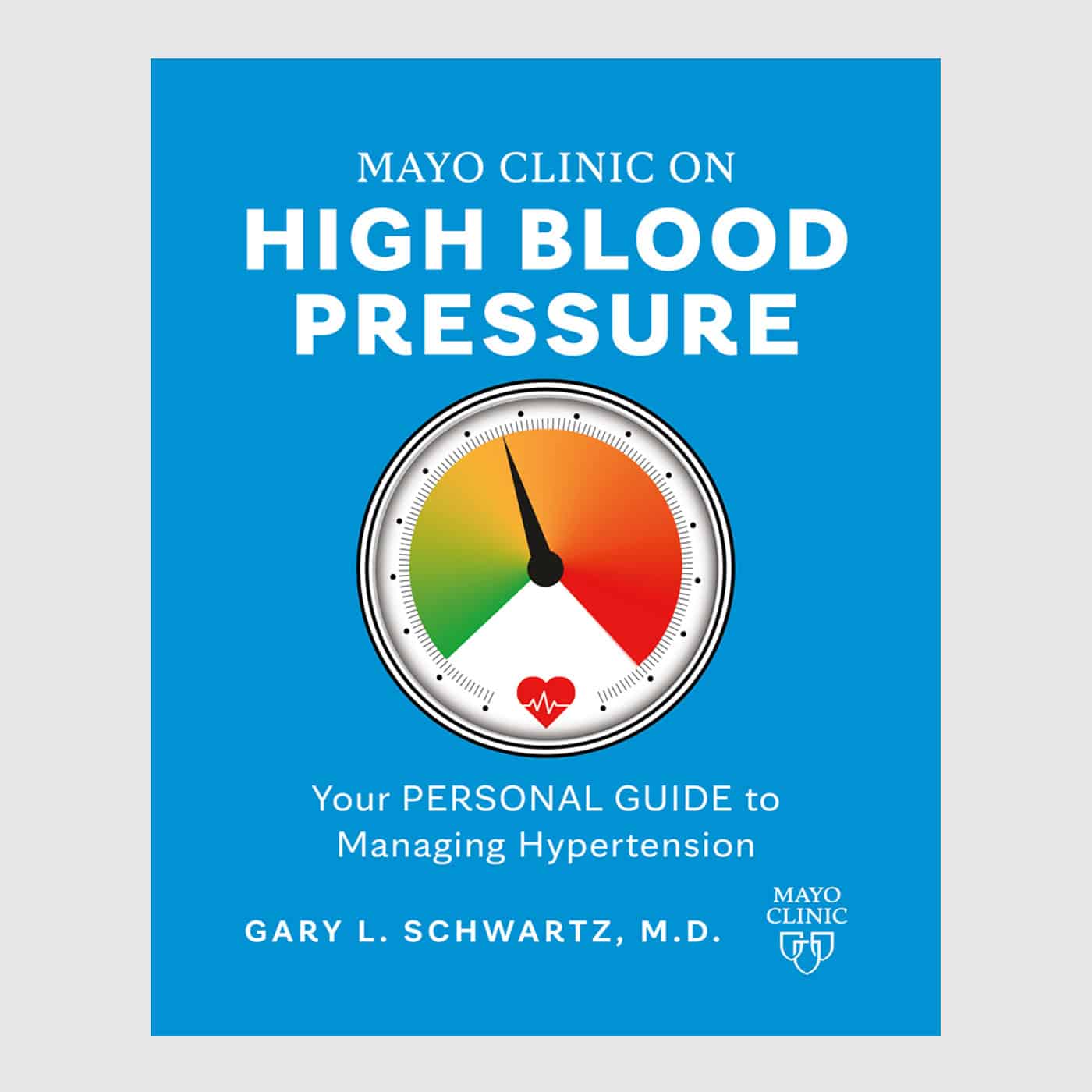
Relevant reading
Mayo Clinic on High Blood Pressure
Mayo Clinic on High Blood Pressure offers information and tools to help you keep blood pressure from building to dangerous levels. By taking specific steps, you can live well with high blood pressure – and even keep it from ever forming. In this book, you’ll learn how high blood pressure develops, what puts you at risk, how it’s diagnosed and treated, and how to reduce your risk of conditions associated with it.

